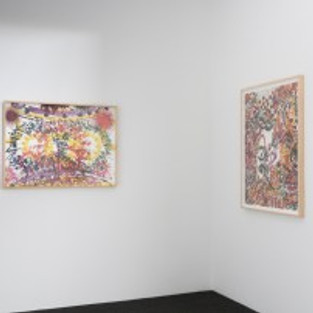Mark Steven Greenfield: Mantras & Musings
- artandcakela
- Sep 16, 2017
- 4 min read

Mark Steven Greenfield: Mantras & Musings. Photo Courtesy of Lora Schlesinger Gallery.
Mark Steven Greenfield: Mantras & Musings
Lora Schlesinger Gallery
By Shana Nys Dambrot
Through October 14th
Cotton is a strange plant, a mallow. A spiked armor cracks into spears, revealing how a soft cloud of white fiber densely billow-blooms, wooden stalks rise and curve like the thinnest of neck napes to hold aloft the sticky filament fuzz. A field of it unfolds like a million tiny queens in powdered wigs with an ethereal gothic feel to its faught expanse. A botanical which is already surrealistic in its regular state, cotton is known for the difficulty of extracting its yield — and of course, the dark power of its economic and cultural associations with America’s original sin. In the imagination of artist Mark Steven Greenfield, the cotton plant’s form and meaning are both teased to the point of abstraction, generating a modern motif made of thousands of tiny wrist actions, echoing the endless twist-and-snap of the cotton-picker’s task. Across a selection of related series, this has been Greenfield’s two-track journey, as he moves simultaneously toward abstraction in form and style, while also refining and amplifying the socially, politically, and personally engaged narratives from which his motifs are derived.

Mark Steven Greenfield: Mantras & Musings. Photo Courtesy of Lora Schlesinger Gallery.
The exhibition includes selected works from 2011-2017, weighted toward the new and recent, which is the ideal way to view the artist’s work. The installation expresses a quasi-chronological but definitive evolution from the most optically exuberant, richly detailed, vibrantly colorful early-series works right through to the refined, small-bore linework of much of the most recent work. The audience sees the paring down of central ideas unfold, and the expanded conceptualization of how best to encapsulate, encode, and disseminate urgent questions about how and what we talk about when we talk about race. His particular knack for confidently distilling the imagery of larger meanings expresses Greenfield’s studio and art-history appreciations, speaking to academic ideas about how abstraction can remain tethered to experience and expressive of story. Because of those advanced formal skills, what Greenfield creates — what he has always created — are paradoxical slow-reveal works which begin as pleasurable, mysterious aesthetic riddles. This gets viewers to linger and look longer and deeper, so that when the message does manifest itself, even be it a thorny or unsettling one, this communication feels organic rather than alarming or accusatory and thus has a better chance of reaching its audience.
Although Greenfield’s work is foremost an exploration of the African-American history, he has taken deliberate steps to view that history in the context of a diaspora that includes not only varied regions of the US but also continental African, Caribbean, and South American experiences — the better to understand the legacy of influences that found their way to the indelible character of the community’s shared yet eclectic domestic history. Mantras & Musings therefore speaks to complex works inspired by an artist residency at Sacatar in Brazil, where he was fascinated with folkloric religious traditions of ancestral wisdom and trickster spirits. The show also includes several powerful works on wood panel exploring both the intricate patterns and implicit messaging of national currency — particularly and presciently salient given the recently reignited debate about replacing Andrew Jackson with Harriet Tubman on the $20 bill. In 2016, Greenfield held a residency in Charlotte at the McColl Center, where his studio looked directly out onto a busy public square — where thousands gathered to protest the police killing of Keith Lamont Scott, which happened shortly after his arrival. Greenfield had been working through a lot of deep regional history in the archives of area institutions, so that the experience became an unlooked-for one of collapsing time, as what was old became new again on national television and outside his front door. The operatic masterpiece “The Charlotte Observer” grew from this experience, combining subjects that had been on his mind with fresh experiences that seized hold of his imagination.
The “On the Money” pieces demonstrate a vigorous penchant for the increasingly abstract, the pattern into which is sublimated a universe of painful ideas. These relate to the “Vague Memories of Cotton” series from 2016, which, along with the earlier work “Tar Baby Acres His Last Attempt at Growing Cotton,” and “Collard Cotton,” both from 2011, and the singularly optically deft “CC One,” “Hive Mantra,” and “CC Two” all from 2017 make plain that Greenfield’s twinned interested in the medium and the message are increasingly operating in tandem on a loftier plane. As a whole, the show and indeed the whole of Greenfield’s oeuvre makes the case that abstraction and storytelling can work together in the right hands, to perform an entirely new way of approaching the most intractable topics — and to be beautiful, graceful, and thoughtful in the process.
#losangeles #losangelesartist #art #history #onlineartmagazine #losangelesart #contemporaryart #linework #MantrasampMusings #artgallery #AfricanAmerican #gallery #shananysdambrot #losangelesartgaller #artandcake #loraschlesingergallery #artexhibition #ArtandCakeLA #fineart #artists #artist #MarkStevenGreenfield #arts #artreview #artexhibit #artmagazine #ArtandCulture


















































